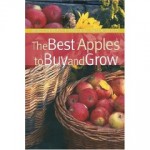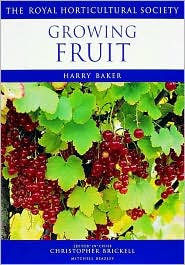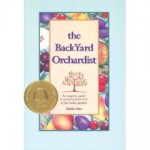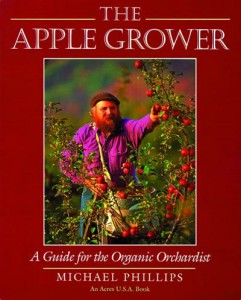Oh, Sweet-Scented Orchard Blossoms! Selecting & Growing Fruit Trees at Walker Farm with Zeke Goodband…
 Apple Blossoms at Scott Farm in Dummerston, Vermont
Apple Blossoms at Scott Farm in Dummerston, Vermont
 The Sweet Scent of Spring: Filling My Hands with Fragrant Apple Blossom Petals as They Fall from the Trees
The Sweet Scent of Spring: Filling My Hands with Fragrant Apple Blossom Petals as They Fall from the Trees
 A Inspirational, Springtime Stroll through the Heirloom Apple Orchard at Scott Farm in Vermont
A Inspirational, Springtime Stroll through the Heirloom Apple Orchard at Scott Farm in Vermont
Many gardeners dream of an orchard filled with homegrown peaches, plums, pears, quince, cherries and apples, fresh for the picking. Fruit trees make wonderful additions to the home landscape, and given proper selection and care, they will provide both beauty and sustenance to the gardener for many years. Spring is the best time of year to plant young fruit trees, and I’m often asked to incorporate them into my garden designs. It’s important for all gardeners —including professionals— to refresh and supplement their horticultural knowledge from year to year, and stay on top of trends. So over the weekend, I joined an eager audience of backyard gardeners at Walker Farm in Dummerston, Vermont, to listen to our local fruit tree expert and orchardist extraordinaire, Zeke Goodband of Scott Farm, share his tips on selecting, growing and pruning fruit trees. I always learn something new from Zeke, and here’s a bit of what he had to offer by way of advice on choosing and caring for young trees in the home orchard…
 Orchardist Zeke Goodband demonstrates proper technique for staking young, semi-dwarf fruit trees in the first two years after planting. Pointing out the need for care when strapping trees to stakes, in order avoid damaging the living cambium layer of the tree, Zeke explains that wire, twine and rope may cut through this important layer of bark. Never tie directly to the tree. Zeke recommends using soft, pliant material —such as cloth or rubber— to create a sling around the bark, in order to protect the tree when anchoring and tying it to stakes.
Orchardist Zeke Goodband demonstrates proper technique for staking young, semi-dwarf fruit trees in the first two years after planting. Pointing out the need for care when strapping trees to stakes, in order avoid damaging the living cambium layer of the tree, Zeke explains that wire, twine and rope may cut through this important layer of bark. Never tie directly to the tree. Zeke recommends using soft, pliant material —such as cloth or rubber— to create a sling around the bark, in order to protect the tree when anchoring and tying it to stakes.
The most important step to take when planting fruit trees —whether an entire backyard orchard or a single specimen tree in the garden— is to properly assess the site. Fruit trees of all kinds require full sun and excellent drainage. In order for trees to flower and develop fruit, they need light from sunrise to sunset throughout the growing season. A little bit of shade in early morning or late afternoon is acceptable —though not optimal— for fruit trees, but a half day of sun or full shade will not provide fruit trees with the conditions they need to grow and produce fruit. In addition, keep in mind that all fruit trees are intolerant of wet soil. So before you get your heart set on a backyard filled with apples and peaches, explore your site with a shovel. Is it poorly drained? If so, choose another site. When the roots of fruit trees sit in wet soil, the tree will slowly decline and eventually die. Equally important, be sure to provide your fruit trees with plenty of room to grow. Even though many modern fruit trees are referred to as semi-dwarf, they still need to be positioned at least 10′ from buildings and other objects, and 15-20′ from other trees. This is important. In order to grow and flourish —and avoid diseases— trees need ample sunlight and airflow.
Another site issue worth considering when planting fruit trees is the presence of wildlife. Deer can cause a tremendous amount of damage to unprotected fruit trees —both to fruit and branches in all seasons— so if deer are common guests to your property, building a fence —at least 8′ tall— is advisable to protect your home orchard. Apple trees are particularly vulnerable to deer browse. For a single tree or small grouping, a more economical, shorter fence may be used to surround and protect the trees.
 Zeke discusses some of the differences between the cherry tree varieties available at Walker Farm, and talks about how to select, and care for young trees after planting
Zeke discusses some of the differences between the cherry tree varieties available at Walker Farm, and talks about how to select, and care for young trees after planting
Once a site has been carefully chosen, fruit trees may be ordered bare-root —from an online source or mail-order catalog— or they may be purchased in pots at local orchards, nurseries and garden centers, where they may be hand-selected. Walker Farm sells many kinds of beautiful, hardy fruit trees —apples, cherries, peaches, plums and pears, to name a few— and most are three years old. Peaches begin to provide fruit at a very young age, and although they are short-lived (Zeke suggests re-planting peaches every 10 years or so), they are quick to provide a sweet reward; making them a great choice for that first tree.
Once your fruit trees arrive to their new home, how well they are cared for will determine your success and future yield. Bare root trees will need to be planted soon after they arrive. If you must wait, be sure to keep the trees in a cool, dark place (such as the box in which they arrived). Soak the roots briefly —while digging the holes— and settle them in with a long, slow drink of water after planting (a 5 gallon bucket of water with small hole for steady drip works well). When planting fruit trees —bare root or potted— Zeke discourages improving the subsoil with compost or manure. The goal is to get the trees to settle in; spreading their roots beyond the planting hole. If the soil is over-enriched, the roots of the tree will likely remain confined to the planting hole, instead of spreading out and properly anchoring the tree. When planting a potted tree, dig the hole slightly bigger than the container and back-fill with the same soil. When settling the tree into the hole, be sure to leave the graft-union —looks like a knobby elbow— exposed 2-4″ above the soil, and then back-fill completely —avoiding air pockets— tamping the soil very lightly with your foot when complete. There’s no need to fertilize or add compost as top dressing until the tree leafs out. Once it does, fertilizer (10-10-10) or compost may be sprinkled around the root area and lightly worked in. Young trees do like nitrogen for the first 3-4 years (and peaches grow and fruit best when given nitrogen every year, throughout their lifetime) but never feed your trees after the 4th of July (and always avoid using tree spikes. Zeke really dislikes these —as do I— because in seasons with dry springs and wet falls, they neglect feeding when needed and then provide it at the worst possible time: when trees need to go dormant). In order to discourage pests and eliminate root competition, it’s very, very important to keep the root area of fruit trees clear of weeds and grass. So, a layer of mulch (2-3 inches at the base), plus regular weed patrol, is a good idea.
Voles and string trimmers —both of which damage the tender cambium layer of bark— are the enemy of young fruit trees. Protect your trees by creating 18″ high, circular wire cages from hardware cloth. Avoid use of plastic tree-wraps, as they harbor harmful pests, including borers. Hardware cloth (made from 1/4″ metal mesh), settled into the ground surrounding the tree, is what Zeke recommends to protect young trees from girdling by hungry rodents and/or nicks from unwieldy lawn crews. You may recall my mention of wire tubes for protecting ornamental trees in winter. The construction of hardware-mesh protection for fruit trees is quite similar (click here for previous post).
Young, semi-dwarf trees should also be supported with stakes for the first couple of years (fully dwarf trees should be supported throughout their lifetimes). Be sure to use a non-binding and non-chafing sling when strapping the tree to the stakes. Never use wire or twine —which may cut through the tender, outer bark— and avoid tying twine directly around the tree. Rubber or canvas slings, secured to the stakes with twine, work well to support young trees and prevent them from toppling or rocking in the wind.
 Zeke demonstrates fruit thinning on a peach tree  —to one peach every 6″ or so— and explains the importance of this technique. Failure to thin heavy crops of fruit may result in broken branches or limbs and poor fruit production the following season
Zeke demonstrates fruit thinning on a peach tree  —to one peach every 6″ or so— and explains the importance of this technique. Failure to thin heavy crops of fruit may result in broken branches or limbs and poor fruit production the following season
When selecting young trees, buy early in the season from a reputable orchard, nursery or garden center, and always have a careful look at the entire tree, including the root zone (lift gently at the base and slide the rootball from the pot to insure a healthy, non-pot-bound tree). Also, have a look at the leaves, bark and the basic structure of the tree. Does it look healthy; free of wilted or skeletonized leaves? Avoid bringing trouble home to your garden, and once planted, keep a regular look-out for tent caterpillars and other pests by checking on your trees, and supplying water if necessary, every few days.
 Zeke demonstrates how vertically-inclined branches on this pear tree are trained to a more horizontal shape through tying techniques
Zeke demonstrates how vertically-inclined branches on this pear tree are trained to a more horizontal shape through tying techniques
After fielding some pest-management questions, Zeke went on to demonstrate formative pruning and tying techniques for training young fruit trees for best production. Pollination of fruit trees by honeybees and other insects is very important, and although many fruit trees are cross-pollinated by wide variety of local, flowering trees, Zeke points out that planting fruit trees in multiple usually gives the best results in terms of fruit production. Getting young, upright trees to flower and produce  —particularly upright pear, plum and apple trees— can be a challenge. To encourage fruit production —which takes place on horizontal branches— Zeke demonstrated how vertical limbs are gently trained in a more horizontal or angled position and tied down. This technique can be used with the more upright varieties of pears, apples, plums, peaches and other fruit trees, to encourage a more horizontally-tiered shape. If you have ever trained a climbing rose to flower (using horizontal fan shape) you will be familiar with this concept. Some trees have a naturally open, horizontally-branching framework and require little tying or pruning to produce fruit. For example, the Japanese ‘Shiro’ plum (Prunus ‘Shiro’) has a lovely, open shape; making it aesthetically pleasing as an ornamental and productive as an edible. In addition to tying, Zeke explained the process of thinning apple blossoms from the average of five per cluster to one or two blossoms per cluster. What about pruning? Zeke advises that over-pruning young fruit trees is a mistake. Other than correcting tight crotch angles and removing competing leaders —or other obvious problems like rubbing or broken branches— avoid pruning fruit trees for the first few years. Later on in the life of your fruit tree, prune trees during winter dormancy to keep the shape low, open and horizontally branching, as well as to remove diseased or seasonally damaged wood.
 Zeke demonstrates how he would prune this young Honey Crisp apple tree; selecting a strong, central leader and removing a competing, vertical branch
Zeke demonstrates how he would prune this young Honey Crisp apple tree; selecting a strong, central leader and removing a competing, vertical branch
If a gardener is hoping to harvest fruit in the near future, adding a few early-to-bear peach and pear trees would be a great place to start. Walker Farm had several varieties of each on hand; including golden ‘Bartlett’ pears and north-hardy, sweet and juicy ‘Redhaven’ peaches. Zeke  discussed some of the best varieties of cherries for our area, noting that trees producing tart fruits —such as ‘Danube’ and ‘Montmorency’— do better than the sweet cherry varieties this far north. But he quickly dispelled the myth that hardy fruit trees grown locally will do better than those grown outside of this region. Because fruit tree varieties are genetically identical, and grafted upon rootstock, a tree raised in Washington (hardy to your zone) has as good a chance of survival as one grafted and raised up the road. Still, I plan to shop for fruit trees locally to take advantage of the expert advice given by lifelong farmers like Zeke Goodband and Jack Manix. An experienced, successful farmer’s words-of-wisdom —and quick wit— are worth their weight in gold.
Thank you to Zeke Goodband for an incredible seminar, and to Walker Farm for sponsoring a spring’s worth of Saturday morning gardening seminars, free to the public! (Click here for information on upcoming seminars, and register to save your seat)
 Â Autumn Apple Harvest at Scott Farm in Vermont
 Autumn Apple Harvest at Scott Farm in Vermont
 And of Course, the Best Part of Fruit Trees is … Experimenting in the Kitchen with Orchard-Fresh, Heirloom Fruit! Click here for French Apple Cake RecipeÂ
And of Course, the Best Part of Fruit Trees is … Experimenting in the Kitchen with Orchard-Fresh, Heirloom Fruit! Click here for French Apple Cake RecipeÂ
Resources for the Home Orchard …
 The Best Apples to Buy and Grow (Brooklyn Botanic Garden All-Region Guide Beth Hanson
The Best Apples to Buy and Grow (Brooklyn Botanic Garden All-Region Guide Beth Hanson
 Growing Fruit (RHS Encyclopedia of Practical Gardening Harry Baker
Growing Fruit (RHS Encyclopedia of Practical Gardening Harry Baker
 The Backyard Orchardist: A Complete Guide to Growing Fruit Trees in the Home Garden Stella Otto
The Backyard Orchardist: A Complete Guide to Growing Fruit Trees in the Home Garden Stella Otto
 The Apple Grower: Guide for the Organic Orchardist Michael Phillips
The Apple Grower: Guide for the Organic Orchardist Michael Phillips
Photographs and Text ⓒ Michaela Medina/The Gardener’s Eden. All photos, articles and content on this site (with noted exceptions) are the original, copyrighted property of The Gardener’s Eden and may not be reposted, reproduced or used in any way without prior written consent. Contact information is in the left side bar. Thank you!
Do you enjoy The Gardener’s Eden? You can help support this site by shopping through affiliate links. A small percentage of each sale will be paid to this site, helping to cover web hosting and maintenance costs. Thank you so much for your support!
2 Replies to “Oh, Sweet-Scented Orchard Blossoms! Selecting & Growing Fruit Trees at Walker Farm with Zeke Goodband…”
Comments are closed.



Thanks Michaela for sharing all those tips on fruit trees. Many of them will help me establish an ornamental tree near the corner of my house. I’m now in my third year trying. First year was a beautiful crabapple that was girdled by voles its first winter. Second year was letting the crabapple bloom as much as it could, then replacing it with an eastern redbud. I used a paper wrap, smelly sprays, and an in-ground sound emitter to protect the redbud trunk from voles during its first winter. So far, so good, but our last winter was not typical. Because of your post, I know now to remove the paper wrap and to build a wire tube for the tree and just leave it there.
I’m so glad this post was helpful, John. Zeke is an amazing talent, and the talk was fantastic. I hope he speaks on the subject again next year! ;) M